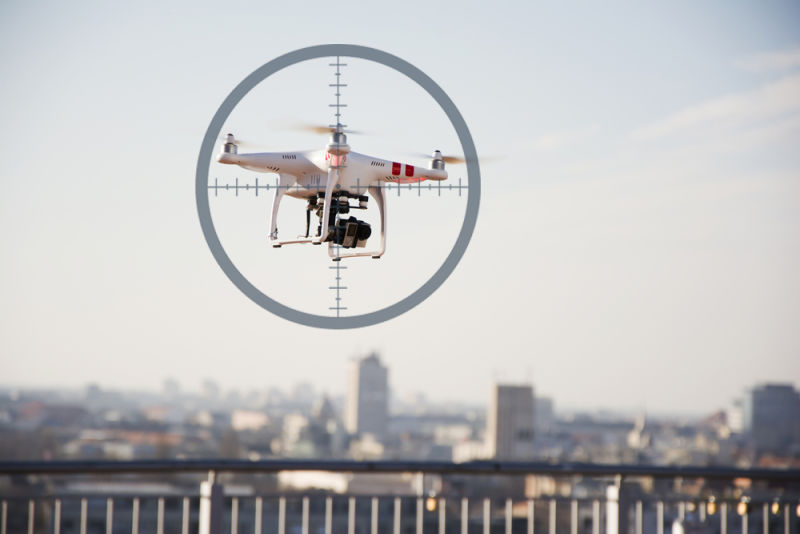From the University of Dayton Research Institute (UDRI) arrives a study on impacts between big aircraft and small drones. Which one will resist to this collision? According to a logic point of view the largest one, of course, but the answer is not so easy to give.
Last year a small quadcopter collided with a large military helicopter. Result? The helicopter sustained only minor damage and returned safely home; the drone was destroyed. However, the University of Dayton Research Institute demonstrated that bigger aircraft will not always resist after such collision.
Researchers in UDRI’s Impact Physics group launched a 2.1-pound DJI Phantom 2 quadcopter at the wing of a Mooney M20 aircraft. The drone did not shatter on impact but tore open the leading edge of the wing as it bore into the structure, damaging its main spar. Kevin Poormon, group leader for impact physics at UDRI assured that the energy and mass together of the small quadcopter damaged seriously the wing. His team collaborated with the Sinclair College National UAS Training and Certification Center, whose experts provided guidance on unmanned aerial systems.
What are the issues
The test has been made to compare a strike between a bird and a drone, using a common hobby drone. The drone and gel bird weighted the same and have been launched at rates designed to reflect the relative combined speed of a fully intact drone travelling toward a commercial transport aircraft moving at high approach speed. Poormon said that the test has been showcased at the Unmanned Systems Academic Summit, held in August at Sinclair College’s Conference Center and its National UAS Training and Certification Center in Dayton.
The idea is to base the study on birds’ damages on aircraft. Poormon said that for 40 years they performed bird-strike tests and generally the damage are limited to the rotor of the helicopters and aircraft. Assured that a drone weighs the same as some bird, the worry is that could be only a matter of time before a drone strike causes more significant damage to a manned aircraft.
And what about risks?
They are testing in order to understand better the kind of damage UAVs can do because at the moment the reality is still unknown because of the lack of data to demonstrate it. The only way to really study and understand the problem was to create an actual collision. As for Poormon, the partnership with Sinclair is precious because they provide drones for testing and can provide valuable insight on how this system are being used to determine new and better models of testing.
The process is like: researchers carry on calibration to control speed, orientation and track of the drone and then they fired a similarly weighted gel “bird” into a different part of the wing to compare results.
Poormon said additional tests using similar and larger drones on other aerospace structures, such as windscreens and engines, would provide critical information about how catastrophic a collision would be. Bird did more apparent damage to the leading edge of the wing, but the quadcopter Phantom penetrated deeper into the wing and damaged the main spar.
Aims
The hope is that the first test result will help bring awareness to the manned and unmanned aviation communities about the importance of regulations related to safe drone operating. The emergence of unmanned aerial systems in the civil and commercial markets is projected to be a significant driver of economic activity and is already providing value across a number of industries, affirmed Andrew Shepherd, executive director and chief scientist at Sinclair’s National UAS Training and Certification Center. The aim is also to positively influence policy and operations to mitigate possible dangers.
________________________
About the University of Dayton Research Institute Impact Physics Lab:
UDRI operates the most diversified impact physics laboratory in the world, with 12 gun ranges capable of propelling objects at velocities ranging from tens of feet per second to more than 33,000 feet per second. Researchers routinely perform research and testing in the fields of foreign object damage, light armor design and evaluation, penetration mechanics, hypervelocity impact testing and analysis, and dynamic behavior of materials.
About the Sinclair College National UAS Training and Certification Center:
Sinclair’s National UAS Training and Certification Center represents the culmination of a focused vision dedicated to creating the most comprehensive and pioneering facility and resources for the advancement of unmanned aerial systems (UAS) technologies. Since 2008, Sinclair College has been at the forefront of UAS innovation, creating partnerships, developing leading curriculum, and investing significantly to establish a nationally prominent program dedicated to meeting the workforce needs of the growing UAS industry.
YOU MIGHT ALSO FIND INTERESTING:

